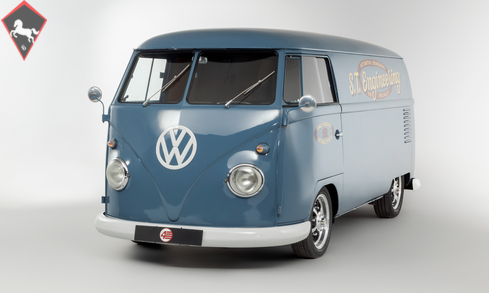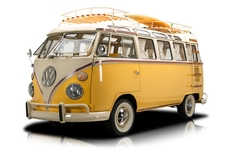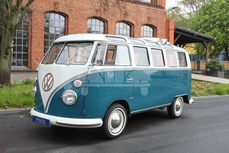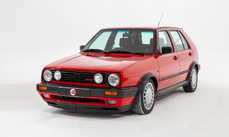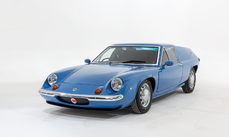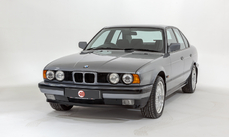Volkswagen Typ 2 (pre 1967) Split Bulli Panel Van 1960
Allmän beskrivning :
Model History
The origin of the VW Type II bus began just after World War II in the VW factory in Wolfsburg, Germany. In 1947, a Dutch importer called Ben Pon, noticed that the motorised trolleys used to transport parts around the factory were made from stripped down Beetle chassis and running gear. He was inspired by these rather strange looking vehicles to sketch a design of a beetle-based van. A year later, the new chief executive of Volkswagen saw potential in this idea and the first VW van was officially launched at the Geneva Motor Show in November 1949. It was known as the Type II because it was the second VW model after the Beetle, the Type I.
By March 1950, ten vehicles a day were being produced. For the next four decades, the basic design remained the same and around five million buses were produced over that time. The Type II with its rear engine and ‘box on wheels’ body, filled a much-needed gap in the market providing a simple but sturdy vehicle that was flexible when it came to transportation but without a high degree of cost.
The unique design of the VW transporter meant that the rear seats could be removed in order to transport greater loads. As the design was so uncomplicated, VW was able to turn out 90 different body combinations over the first five years. These variations included buses, pick-ups, fire engines, ambulances, beer wagons, refrigerated ice-cream vans, milk floats, bread vans, mobile grocers, ordinary delivery vans and the well known and loved camper.
From 1949 until 1967, Volkswagen produced the first generation of VW buses in the form of split screens. These “splitties” earned their name due to the split windscreen and they also sported a sweeping v-line front. Their rear air-cooled flat 4 engine was simple and reliable.
Equipment
Dove Blue paintwork, Hand-painted VW specialist signwriting, Grey leatherette front seats, 2110cc flat 4 engine, 4-speed manual gearbox, Side loading doors, Walk-through rear cabin, Handmade cabinetry, Rear bench seat, Ply-lining, Alpine radio head unit, Britax picnic set, Twin-burner stove, Front brake discs, Larger rear brake drums.
Exterior
This amazing split-screen panel van has been owned by ST Engineering for the last 13 years and has been kept as a display piece in their showroom to show-off the quality of their work. The owner of ST Engineering is a true VW fanatic and searched long and hard to find this example, an ex-California van in amazing rust-free condition. Other than the company sign writing done by an old school craftsman – using traditional paints and gold leaf – the van has not required any paintwork in the current owner’s 13-year ownership, which is a true testament to the quality and structure of this example.
On closer inspection the body is completely free from any signs of corrosion or previous poor repairs, the panel gaps are first-rate and the van is incredibly straight down both sides. Being really critical there are probably five or six stone chips to the front end but other than that it’s totally unmarked. All of the chrome work is in fantastic original condition with only a tiny amount of patina on the handle on the rear side doors. Both bumpers are pristine, there are no cracks or chips to any of the light lenses, and the rubber seals around the windscreens and doors are in perfect condition. Tucked behind the rear bumper there is a fold out towbar that’s perfect for a bike rack or small camping trailer.
VIEWINGS WELCOME BY APPOINTMENT ONLY /// ADDITIONAL PHOTOS AVAILABLE UPON REQUEST
Interior
Starting up-front, the dashboard is in perfect condition and has never had any aftermarket gauges or instruments cut into it, so remains without a fuel gauge! The original steering wheel is also in lovely order with only a couple of very light cracks starting; the gear knob is perfect as is the front rubber mat and door cards. The only non-standard additions are an Alpine head unit mounted below the dash and a couple of 6x9 speakers in the doors. This example benefits from a walk-through cabin allowing you to access the rear of the van without getting out and potentially rained on. The vinyl seats themselves are in great condition with only a few small marks as seen on the base of the driver’s seat.
Moving into the back of the van the current owner has had some beautiful 60s-style cabinetry hand made with plenty of storage for all the camping equipment and paraphernalia you might want on a weekend away. The unit behind the passenger seat houses a small gas bottle for the Propex heater, an 810 amp leisure battery and an original Britax picnic set. The lift-up lid folds to reveal space for the new owner to fit a twin-burning stove. The fabric on the seats is very cool, beautifully tailored and in first-rate condition. All of the ply on the roof and in the side panels is in great order too, and the two wires poking out of the side panel between the seats are ready for the new owner’s choice of light. The rock ‘n’ roll bed works well with further storage beneath.
ENGINE & TRANSMISSION
Looking inside the engine bay all of the Dove Blue paintwork is immaculate with no signs of corrosion or any previous poor repairs. The motor itself is a 2110cc – a massive upgrade over the standard 1600cc unit – and it features 92mm pistons and a long 82mm stroke camshaft. This provides masses of low-down torque and makes for comfortable motorway cruising.
WHEELS, TYRES & BRAKES
The Flat4 GTV alloys suit the van perfectly and are in pristine condition with no curb marks or lacquer peel. The front Yokohama tyres are brand new and the matching rears have only driven a few hundred miles. On a service earlier this year the brakes were gone through and so are in fine working condition. On the front it has CSP discs and the rear benefits from larger drums from a VW Type 3 variant.
History File
This 1960 example started life in California, then headed for a period in Jersey before being imported by the current owner and coming to the UK in 2009. For the last 13 years the van has spent most of its life as a showpiece in the ST Engineering showroom with a few trips out and a couple of camping holidays. The owner is now selling the business hence why the van is also up for sale. ST Engineering have given it a full inspection and service ready for the new keeper’s peace of mind.
The accompanying History File contains the V5C showing just 1 UK owner, MOT certificates since being in the UK, all of the import paperwork, and a six-page spread in Volkswagen Camper magazine.
http://www.4starclassics.com/for-sale/vw-splitscreen-panel-van-for-sale/
1960 Volkswagen Typ 2 (pre 1967) Split Bulli Panel Van is listed såld on ClassicDigest in Kingsley by 4 Star Classics for £34995.
Fakta i bilen
Karosstyp : Personbil Märke : Volkswagen Modell : Typ 2 (pre 1967) Split Bulli Modellversion : Panel Van Motorvolym : 2.1 Årsmodell : 1960 Karosstyp : Van Läge : Hampshire
Såld
Information om säljaren
Såld
People who viewed this Volkswagen Typ 2 (pre 1967) Split Bulli also viewed similar Volkswagen listed at ClassicDigest
Other cars listed for sale by this dealer
om Volkswagen
Volkswagen-berättelsen är verkligen en spännande berättelse om innovation, motståndskraft och efterkrigstidens väckelse, präglat av olika modeller som har blivit ikoniska i bilhistoria.People's Car (Volkswagen): Ursprungligen föreställt av Adolf Hitler på 1930 -talet som en "folks bil" eller "Volkswagen" på tyska, var tanken att skapa ett prisvärt och praktiskt fordon för det tyska. Detta koncept ledde till utvecklingen av Volkswagen Beetle (eller typ 1), designad av Ferdinand Porsche.
Efterkrigstidens utmaningar: Efter andra världskriget mötte Volkswagen betydande utmaningar. Fabriken skadades kraftigt, och varumärkets förening med den nazistiska regimen ledde till brist på intresse i bilen i vissa regioner.
Brittisk intervention - Den brittiska armén & Ivan Hirst: Den brittiska armén tog kontrollen över fabriken under den omedelbara efterkrigstiden. Major Ivan Hirst, en brittisk arméoffiser, spelade en avgörande roll för att återuppliva Volkswagen. Han erkände potentialen i skalbaggen och förespråkade för dess produktion och övertygade den brittiska militären att beställa flera tusen bilar. Detta beslut hjälpte till att starta varumärkets väckelse.
Exportframgång och Beetle's Global Appeal: The Beetle fick popularitet inte bara i Tyskland utan också globalt och blev en ikon för prisvärd bil. Dess enkla, pålitliga design och unika utseende gjorde det till en favorit bland konsumenterna över hela världen.
Modell Evolution: Under åren introducerade Volkswagen olika modeller tillsammans med skalbaggen, var och en bidrog till varumärkets tillväxt:
Typ 2 (VW -buss eller transportör): Introducerad på 1950 -talet blev det en ikonisk symbol för hippie -rörelsen på 1960 -talet, älskad för sin rymlighet och mångsidighet.
Golf (kanin i USA): Lanserat i mitten av 1970-talet markerade golfen (eller kaninen i USA) en förskjutning mot framhjulsdrivna, moderna design och hatchback-praktik och blev en hörnsten i varumärkets framgång.
Passat, Jetta och andra modeller: Volkswagen utvidgade sin sortiment med modeller som Passat och Jetta, som catering till olika marknadssegment.
Utmaningar och innovationer: Trots framgång mötte Volkswagen utmaningar, inklusive kvalitetsfrågor på 1970 -talet. Varumärket fortsatte dock att förnya och utveckla nya modeller och tekniker.
Rise of the GTI och Global Expansion: 1980-talet såg ökningen av den ikoniska Golf GTI, en högpresterande version som ledde till den heta lucktrenden. Volkswagen utökade också sin globala närvaro under denna period.
Det brittiska ingripandet i att återuppliva Volkswagen efter andra världskriget spelade en viktig roll i varumärkets återupplivning. Även om det kan ha varit några spänningar eller konkurrens mellan bilföretag på 1950- och 1960-talet på grund av Volkswagens framgång efter kriget, stärkte varumärkets förmåga att producera innovativa och populära modeller sin plats i bilhistoria.
